
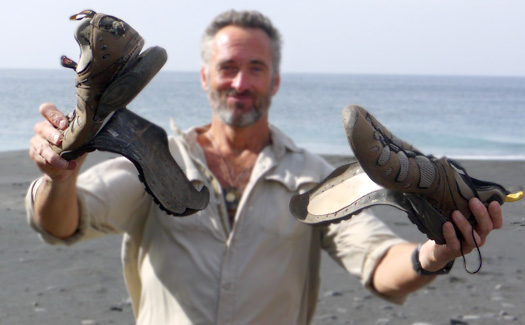
|
Dec 31, 2019 (Day 4,597)
Quick Fix: 16° 53.1 N / 24° 59.5 W
Mindelo, Cape Verde

Last Hike
This morning I woke at 0500 to meet Paulo of Green Line Tours for my last hike of 2019. Long before the sun had appeared we were rattling along a corrugated dusty road so remote even locals get lost, which we did, taking two wrong turns in the pitch black, one leading to a dead end and startled cows caught in our headlights. By 0630 we had made it to a ridge where, under the low whirring and whooshing of a giant isolated wind turbine, we waited for light, and by 0700, with just enough to see, we trudged along a whisper of a goat trail over a high ridge before dropping into the rocky valley of Ribeira de Cascavelhoa down to a remote black volcanic sand beach on the island’s east coast. My shoes, which have traveled around the world, finally reached their limit and during the morning peeled apart in floppy layers of tread and support until only the foot cover remained. We watched the sun rise with a Romeo y Julieta and a little Havana Club while sharing life stories and plans for 2020. It was a perfect way to end the year. Now, after the 8-mile hike at a pace that was close to a jog, I hope I can go the distance tonight. |
|

|
 |

|
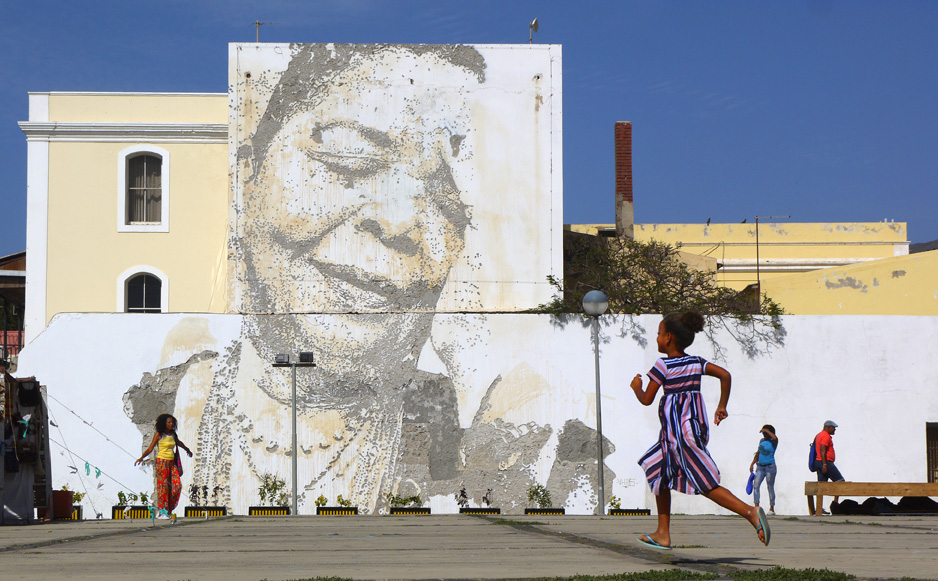
Dec 28, 2019 (Day 4,594)
Quick Fix: 16° 53.1 N / 24° 59.5 W
Mindelo, Cape Verde

Cape Verdean Identity
We've had a whole week to explore Mindelo, Sao Vicent's port city, and it is an intoxicating place, radiating a charm that is uniquely African-Portuguese while making all the noise of a proud, independent, developing island nation busy establishing an identity and eager to prove itself to the world. The city feels bustling with optimism - a cruise ship dock is in the works and in 2021 a prestigious fleet of elite racing yachts will add Mindelo to the world circuit of The Ocean Race. Mindelo was home to the Grammy Award-winning Cesária Évora, a local singer / songwriter who launched her career at the age of 16 performing in a local sailor's tavern and later on cruise ships before her album, Voz d'Amor, put her on the world circuit. Sadly in 2011 she passed away, but her music lives on and locals are proud of her success. A statue of Cesária greets visitors at the island's airport and just a month ago Portuguese artist, Vhils, spent three days chipping away plaster in Praça D. Luis to reveal a mural of Cesária that seems to capture the singer, and the city's rustic spirit, perfectly. |
|

|

| Dec 21, 2019 | Santo Antao, Cape Verde - Balancing on the edge of Cova de Paúl. |
|
| |

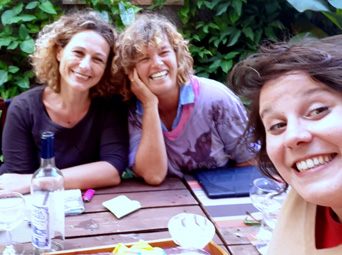
|
|
|
 |
Day 4,587 - Santo Antao, Cape Verde
20:51 hrs - December 21, 2019
The Great Green Line Tour Group |

Our guide greeted us wearing a Boston Red Sox beanie ("The B is for Brooklyn, son") and a black hoodie. Paulo, a native of Cape Verde had moved to Boston, then Brooklyn for a few years before meeting his wife until, missing these quiet islands, returned with his family to open the company Green Line Tours (a nod to the subway line near their old Bostonian apartment and the ‘Verde’ in Cape Verde). A last minute booking also had Alessandra and Carmela, two beautiful Sicilian woman on vacation, join our group and so together, before the sun had even peeked over the horizon, the five of us shuffled onto the early morning ferry bound for the neighboring island of Santo Antão, Cape Verde's second largest island and considered a paradise by locals for its rich soils and green terraced valleys. Our group’s chemistry was immediate, Paulo's enthusiasm infectious, and the Sicilian girls expressive banter and humor had us feeling like old friends reunited even before the ferry docked in Porto Novo an hour later.
George, Paulo's childhood friend, our driver for the day and a local to Santo Antão, met us at the dock and with a round smiling face and a flurry of Portuguese, introduced himself and welcomed us to the island. After coffee and local corn bread smothered in butter, we bundled into the van and set off from Porto Novo, trundling along a bumpy road that took ten years to build, literally one cobble stone at a time, which climbed from shoreline to ridge line, sea to sky where, at the apex 1,500 meters above the Atlantic, it balanced on the very edge of Cova de Paúl, a volcanic caldera offering dizzying views into craggy valleys disappearing to the ocean far below. A flat tapestry of sheltered farmlands filled the crater floor, which last erupted 200,000 years ago. But recently these fertile soils are rarely watered from direct rain, prolonged droughts are becoming an increasing concern for these islanders, but rather from moisture delivered by clouds that roll in gently from across the sea, spilling and flowing over the ridge to cool the interior below.
We continued our tour by driving further along the ridge along a portion of road so narrow, with plunging views so steep, it felt like crossing an ancient bridge, where far below, valleys brimming with banana trees, mangoes, papaya and terraces of corn reminded us equally of the Marquesas and Indonesia. Footpaths leading farmers to remote terraces clinging to the side of cliffs seemed impossible to access and would have even mountain goats considering an easier route. But the locals we met on the Ribeira de Torre, Xôxô trudged up and down trails with the kind of grim determination and resolution that comes from a lifetime of having few other options. We met an old woman of 78 climbing along a cobbled stepped path so steep it would overwhelm most Americans half her age. And we passed woman carrying heavy supplies balanced on heads - great bowls of fruit, thick logs of wood for kitchen stoves, and one with a full canister of cooking gas. They stopped occasionally to rest in the shade of banana leaves but mostly they walked, eyes down and determined.
During the valley stroll our group thinned and Carmela, eager to explore, trekked up into the hills. Concern grew after an hour of waiting, and locals we met during the search shared stories of a tourist marching up hill at speeds never before seen in the valley. With professional concern Paulo went to locate his missing charge. Perhaps due to exhaustion or panic, Paulo momentarily forget Carmela's name and spent thirty minutes calling out for "MARCELLO! MAAARCELLOOO!!" He did eventually find her, on a distant ridge happily exhausted and with a smart phone full with photos of smiling and bemused locals she met along the way.
We lunched in Ribeira Grande on a local dish of fish, chicken, beans, rice and vegetables. We drank far too much Strela, a local beer, Portuguese wine, rum and shots of grogue, moonshine distilled from sugarcane and a drink Paulo vehemently described as 'poison' and strongly suggested we limit to one each.
It was a great day and not wanting the tour to end, we continued into the evening. George, our driver, needed little encouragement to abandon his plans to return home that night, and instead joined us on the ferry all the way back to Sao Vicent, where we continued the merriment until three in the morning.
The day was unforgettable and a wild success. Thank you Paulo, Alessandra, Carmela and George. We're already dreaming of our next rendezvous.

|

| Dec 21, 2019 | Santo Antao, Cape Verde - Atlantic clouds watering Santo Antao. |
|

| Dec 16, 2019 | Sao Vicente, Cape Verde - Climbing the narrow, black cobbled road to the summit of Monte Verde. |
|
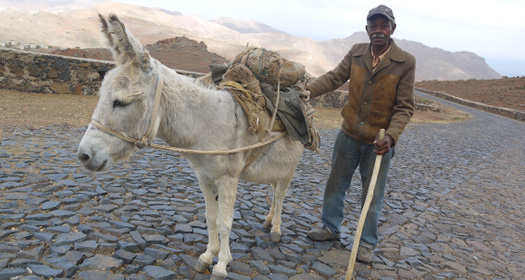
|
Dec 16, 2019 (Day 4,582)
Quick Fix: 16° 53.1 N / 24° 59.5 W
Mindelo, Cape Verde

Cape Verde
Sao Vicente has all the colorful dusty noisy chaotic charm of a developing African nation, and we love it already. Our first day had us walking through Mindelo, the island's port city, along Rua Libertadores d’Africa watching locals complete a half marathon with a finish line marked by giant speakers blasting reggae, and where grim faced military police, wearing shiny boots and camouflaged fatigues, seemed indifferent to a gang of locals racing up city streets pulling wheelies on mini dirt bikes. We toured the island by car on day two, driving a narrow cobbled road all the way to the summit of Monte Verde, where we passed an old man pushing his donkey up a particularly steep incline, then lunched on a remote beach, grilled tuna steaks, at a restaurant made from old shipping containers and where two kite surfers had 25 knots of wind and 10 foot surf all to themselves. We've decided to stay for Christmas and New Year. |
|

|
 |

| Dec 15, 2019 | Sao Vicente, Cape Verde - The colorful fishing fleet of Porto Calhau at rest on the eastern shore of Sao VIcente. |
|
| |

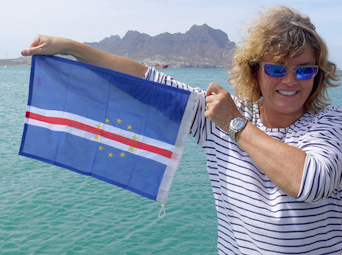
|
|
|
 |
Day 4,579 - Mindelo, Cape Verde
19:12 hrs - December 13, 2019
A Happy Ending |

About a tea cup's worth - that's all the fuel we used traveling the 887 nautical miles from the Canaries to Cape Verde. We ran the engine for just fifteen minutes when departing Gran Canaria, for the rest of the voyage we were powered by the wind. In fact, we even sailed right into the anchorage (although not by choice, our starter solenoid decided not to work and released a concerning plume of smoke), so we coasted into Porto Grande on Sao Vicente's northern shore under sail alone, just as the Portuguese did in 1456 when they first discovered these islands. Thankfully wind, seas and a roomy harbor were favorable, and with fire extinguisher at the ready, we ended our passage without drama.
During our six day voyage we sighted one sailboat, White Lady, also bound for Cape Verde, a tanker heading north, a pod of dolphins, some pilot whales, and a giant sea turtle floating on the surface who, stretching his neck, eyed us as we sailed past. We gave sea burials to five flying fish stranded on our decks, and one tiny squid.
Wind (turbine), sun (solar) and seas (tow generator) kept our batteries fully charged for the entire passage, and even while operating all our navigational equipment, autopilot, radio, fridge/freezer and lights, and after charging every mobile device we could find, including our electric toothbrush, we still had such a surplus of power we often had to restrain the wind turbine during the day.
All in all it was a good run. A little rolly, yes (see below), so we're happy to be at rest. We're now only 2,000 nautical miles from the Caribbean. But first, we've got a little Cape Verde to explore... |

|
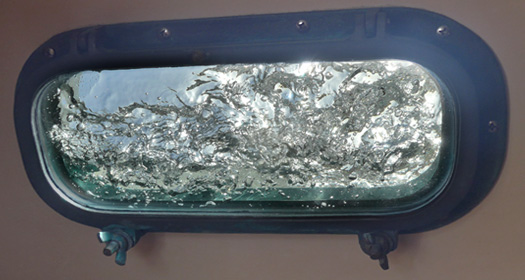
|
Dec 11, 2019 (Day 4,577)
Quick Fix: 20° 32.2 N / 21° 39.9 W
Sailing to Cape Verde

Awash with the Sea
Catherine's first logbook entry for this passage reads, "Rolly, rolly, rolly + rolly!" We're now four days, 590 nautical miles into our sail to Cape Verde, and with 30 knots of wind blowing eagerly across the stern, conditions have been lively. Thankfully the wind has eased to a more civilized 20 knots, but the waves are still causing mischief with 8 to 10 foot seas racing to catch us. Some roll under our keel without a bother, but the more determined sets build, bubble and tumble, thumping over our caprail and go cascading about the decks, swishing from one side to the other before gurgling a noisy escape through the scuppers. The Atlantic is having fun with us. We have a salty soggy pile of old towels in the cockpit, but after years of replacing gaskets and seals, our cabin below remains cozy and dry - even when the port lights are entirely awash with the sea. |
|

|
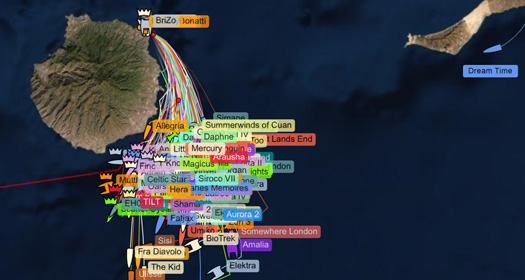
|
Dec 6, 2019 (Day 4,572)
Quick Fix: 28° 07.9 N / 15° 25.5 W
Gran Canaria, Canary Islands

Clear For Departure
A record number of boats participating in the ARC Rally, 283 to be exact, departed Grand Canaria last month for the Caribbean. So overwhelming was the fleet's size that it prompted local authorities to warn mariners by broadcasting a PAN-PAN, referring to the fleet as a "navigational hazard", which seemed a little harsh to me. Although maybe they were right? We arrived in Las Palmas the following day, not by coincidence, and have spent the last two weeks leisurely preparing Dream Time for her own Atlantic crossing, which she will begin tomorrow. It's 3,000 nautical miles to the Caribbean from here, but as we're not in a hurry we've decided to make a pit stop on the islands of Cape Verde, an African country 850 miles to our south. The weather forecast is clear, and with the ARC Rally now well over the horizon, navigating our departure will be a cinch. |
|

|
| |

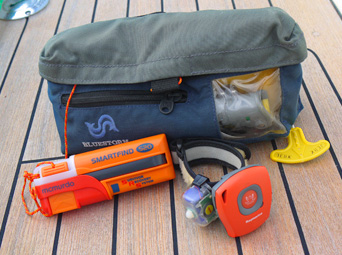
|
|
|
 |
Day 4,571 - Gran Canaria, Canary Islands
17:48 hrs - December 5, 2019
Safety Upgrade 5.0 |

"One hand for the boat," pretty much covered my safety strategy back In my twenties and remarkably, with no cruising experience or serious regard for consequences, I sailed from Australia, across the Indian Ocean and up the Red Sea to the Mediterranean without incident.
In my thirties, however, when Catherine and I began cruising offshore on Dream Time, I took our personal safety a little more seriously, investing in Raymarine MOB lifetags - watch-size transmitters that promise to trigger an ear piercing alarm inside the boat to alert a sleeping spouse should the other topple overboard. Truth be told, the motivation to buy this device came not to directly benefit the wearer lounging in the cockpit, but more to assist the off-watch spouse in securing a sound sleep, resting comfortably with the knowledge that their partner was still somewhere on board. The alarm has been triggered once in twelve years of world cruising, whilst sailing from New Zealand to Fiji, when perched on the very end of the bowsprit I recorded some spectacular dolphin footage with my arm extended just beyond the unit's working range. Let's just say the alarm worked marvelously and had Catherine wide awake, in the cockpit within fifteen seconds, and not speaking to me for the remainder of the day.
During my forties we explored the South Pacific, New Zealand, Australia, Southeast Asia and returned to the Mediterranean Sea. Passages were long and remote in the Pacific, so when we reached Australia we added a nifty water-activated strobe light to our lifetag strap which can be seen blinking at a distance of up to three miles. Unobtrusive, both the lifetag and strobe light are worn on the wrist of whoever is on watch, regardless of conditions, day and night, and are small enough not to interfere with movement, line handling or lounging.
And now, as I approach the fifth decade of my life, the accumulation of cruising experiences, observations and available technology have me reassessing our gear once again and introducing another upgrade to help ensure our safety. You could make an excellent case right about now, arguing that we should simply wear life jackets and harnesses all the time. And of course you would be right. But we cruise not just to explore the world, but for our independence and yes, even the calculated recklessness and adventure of the life we choose to live at sea, and wearing a harness, tugging around a leash all day, every day on a passage, is not a realistic solution for us, especially considering on many days even board shorts seem unacceptably constraining. But we're not reckless, when conditions deteriorate we don't hesitate to reach for our life jackets and harnesses, which are stowed next to the grab bag and EPIRB in the companionway, and in sporty seas we clip to jacklines if staggering around the deck is required. But under normal cruising conditions, the less we have to wear the better.
While our lifetag does an impressive job of instantly, and loudly, signalling an MOB situation, it does not provide an active or real-time position fix of the person splashing around in the water. The strobe light will mark the location at night, but in big seas or poor visibility cannot be relied upon. So our most recent upgrade is a personal AIS MOB transponder.
This pocket size unit, when activated, sends a SART icon (Search And Rescue Transponder) via satellite to any AIS-compatible screen within a range of about ten miles to pinpoint the exact position of the device. We've attached ours to an inflatable life vest belt, the unit fits neatly inside the waist bag and if the vest is deployed, the AIS beacon is right where you'll need it.
Technology moves a lot faster than Dream Time and we don't try to keep up with all the changes. But we do adopt upgrades when we recognize they'll improve our lifestyle and safety at sea. In just a few weeks we'll begin our passage across the Atlantic Ocean, and I think it's safe to say that we have never been better prepared. And barring any attempts, by me, to record dolphins playing off the bow, the voyage should be a peaceful one. |

|

| Dec 2, 2019 | Gran Canaria, Canary Islands - The sun drenched Dunas de Maspalomas. |
|
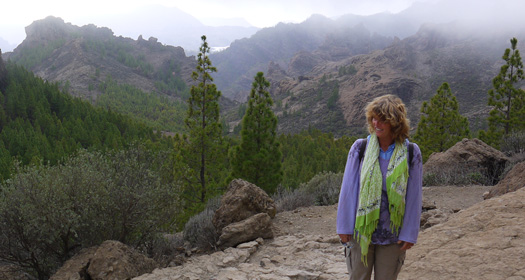
|
Dec 2, 2019 (Day 4,568)
Quick Fix: 28° 07.9 N / 15° 25.5 W
Gran Canaria, Canary Islands

A Taste of Gran Canaria
From sea level to cloud line we have toured all of Gran Canaria, and it has been a delight. The serpentine coastal road meandered and flowed perfectly around the island's southwestern shorelines, tracing narrow valleys lined with prickly pears one minute, then clinging to jagged vertical cliffs the next where wild Atlantic surf molested rocky shores 1,000 feet below. We bought fresh oranges and mandarins, the best we've ever tasted, from local farmers at roadside stalls. We passed colorful cyclists on merciless inclines in gears so low their legs looked like running sandpipers. We even met a stranded rollerblader who needed a lift, somehow he had failed to consider the ‘going up’ portion of his day. In the island's center we hiked to Roque Nublo, 5,948 feet above Dream Time and 30 degrees cooler, and were rewarded by an entrepreneurial vendor selling hot chocolate so thick you needed a spoon to drink it. |
|

|
 |

| Dec 2, 2019 | Gran Canaria, Canary Islands - Touching the clouds at the island's center, a chilly 5,948 feet above Dream Time. |
|

| Dec 1, 2019 | Gran Canaria, Canary Islands - No lens distortion used here, and this is considered one of the straighter portions of GC-200. |
|
|
|

 |
|

